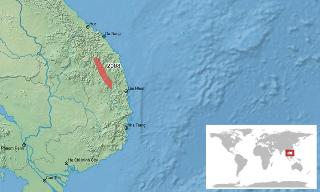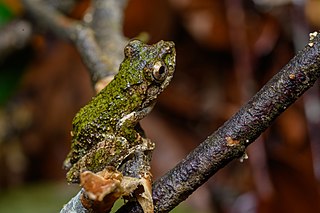
Leptobrachella tuberosa, also known as the granular toad, is a species of frog in the family Megophryidae. As currently known, it is endemic to the Central Highlands of Vietnam in Gia Lai, Quảng Nam, and Thừa Thiên–Huế Provinces. Its true range is probably wider as suitable habitat extends further north and east, reaching northeastern Cambodia and southeastern Laos. The specific name tuberosa is derived from the Latin tuberosus, meaning "full of protuberances".

Amolops cremnobatus is a species of frogs in the family Ranidae. It is found in north-central Laos and Vietnam. Its range might extend into Thailand. The specific name cremnobatus is derived from Greek kremnobates, meaning "frequenter of steep places", and refers to the steep waterfall from which the type series were collected. Common name Lao sucker frog has been coined for it.

Amolops spinapectoralis is a species of frog in the family Ranidae, the "true frogs". It is at present only known from a few locations in central Vietnam—that is, it is endemic to Vietnam—but it is likely to be found more widely in the Vietnamese Central Highlands as well as in the adjacent southeastern Laos and northeastern Cambodia. The specific name spinapectoralis is derived from Latin spina for "thorn" and pectoralis for "of the breast" and refers to the pectoral spines in adult males. Common name spinyback torrent frog has been coined for it.
Odorrana orba is a species of frog in the family Ranidae. It is found in southeastern Laos and central Vietnam. The specific name orba is Latin for "orphan", referring to the fact that this species was—at the time of species description—known in Vietnam only from a single juvenile.
Feihyla palpebralis is a species of frog in the family Rhacophoridae, sometimes known as the Vietnamese bubble-nest frog or the white-cheeked small treefrog. In addition to its type locality, Langbian Plateau in southeastern Vietnam, it is found in southern China and northern Vietnam south to Tam Dao, and is expected to be found in the intervening Laos and Vietnam.
Philautus abditus is a species of frog in the family Rhacophoridae. It is found in the highlands of central Vietnam as well as in extreme northeastern Cambodia. The specific name abditus is Latin for "hidden" or "concealed" and refers to the black spots on the legs that are concealed while the legs are flexed.

Leptomantis angulirostris, commonly known as the masked tree frog, is a member of the tree frog family Rhacophoridae and is found in Indonesia and Malaysian Borneo. Its natural habitats are subtropical or tropical moist lowland forests, subtropical or tropical moist montane forests, and rivers. It is threatened by habitat loss.
Rhacophorus baliogaster, also known as the belly-spotted frog, is a species of frog in the family Rhacophoridae. It is found in the Central Highlands of Vietnam and the Annamite Mountains of adjacent Laos. Its range probably extends into eastern Cambodia where suitable habitat should be present. The specific name baliogaster is derived from the Greek words balios and gaster, meaning "spotted or dappled belly".

Kurixalus bisacculus is a species of frog in the family Rhacophoridae. It is found in Southeast Asia and southern China. Because of confusion with other species, the distribution is not well mapped but includes Thailand, Cambodia, Laos, Vietnam, and China. Populations from Hainan were formerly treated as a separate species, Rhacophorus hainanus, but molecular data suggest they are conspecific with Kurixalus bisacculus.
Leptomantis gauni is a species of frog in the family Rhacophoridae. It is endemic to Borneo and is found in Sabah and central Sarawak (Malaysia), Brunei, and north-eastern Kalimantan (Indonesia). The specific name gauni honours Gaun Sureng, a collector for the Sarawak Museum and a companion to Robert F. Inger on field trips when this species was observed. Common names short-nosed tree frog and Inger's flying frog have been coined for it.

Rhacophorus margaritifer, also known as the Java flying frog or Javan tree frog, is a species of frog in the family Rhacophoridae. It is endemic to Java, Indonesia. It is known from several areas in Java. It is locally known as katak-parasut jawa.

Rhacophorus rhodopus is a species of frog in the moss frog family (Rhacophoridae). It occurs in south-eastern Asia, from India to southern China, and south to Malaysia. Previously unknown from Laos, it has now been found in Phongsali Province and at Luang Prabang. Its taxonomy is disputed.
Leptomantis rufipes is a species of frog in the family Rhacophoridae. It is endemic to Borneo and known from isolated locations in south-central Sarawak and eastern Sabah and central Kalimantan (Indonesia). Common names Malaysian flying frog and red-legged frog have been coined for this species. The specific name rufipes refers to the red webbing of this frog.
Papurana attigua is a species of frog in the family Ranidae, the "true frogs". It is found in central and south Vietnam, eastern Cambodia, and southern Laos. The specific name attigua is derived from Latin attiguus meaning "neighbor". It refers to the similarity of this species to Indosylvirana milleti. The common name similar frog has been coined for this species.
Chalcorana rufipes is a species of "true frog" in the family Ranidae. It is endemic to Sumatra, Indonesia. It was split off from Chalcorana chalconota by Robert Inger and colleagues in 2009, along with a number of other species. The specific name rufipes is derived from Latin rufus meaning reddish and pes meaning foot, in reference to the reddish tinge on the underside of the pedal webbing in life.
Theloderma palliatum is a species of frog in the family Rhacophoridae. It is endemic to Vietnam and so far only known from the Bidoup Núi Bà and Chư Yang Sin National Parks. This species, together with Theloderma nebulosum, was first found by Australian and Vietnamese scientists in Tay Nguyen in 2011.
Rhacophorus robertingeri is a species of frogs in the family Rhacophoridae endemic to Vietnam. First found in the Annamite Mountains of Vietnam, it is now known from mountain areas between Hà Giang or Nghệ An Province in the north and Gia Lai or Bình Thuận Province in the south, depending on the source. This species can be differentiated from its congeners based on the pointed projection at the tibiotarsal articulation, as well as coloration.
Zhangixalus jarujini is a species of frog in the family Rhacophoridae. It is endemic to north-eastern Thailand and known from the Kalasin, Roi Et, and Ubon Ratchathani Provinces. The specific name jarujini honours Jarujin Nabhitabhata from the National Science Museum of Thailand. Common name Jarujin's treefrog has been coined for it.
Roesler's bent-toed gecko is a species of lizard in the family Gekkonidae. The species is endemic to Southeast Asia.

Zhangixalus is a genus of frogs in the subfamily Rhacophorinae, family Rhacophoridae. They are collectively known as Zhang's treefrogs. They occur in the Eastern Himalayas, southern China, Taiwan, Japan, and southeast Asia.








